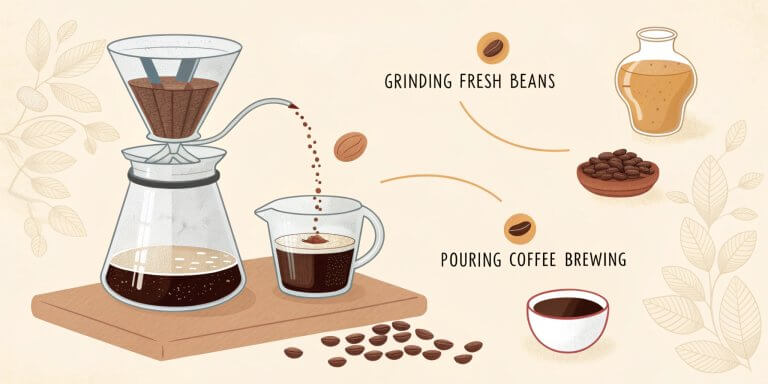
Ever wondered why your cold brew packs such a punch? Or you’ve noticed that your go-to cold brew gives you a bigger boost than your regular coffee. You’re not alone! Cold brew has become a popular alternative to traditional hot coffee, and it’s easy to see why. It’s got that smooth, rich taste that many people love, and there’s a common perception that it might be higher in caffeine.
With more and more people choosing cold brew as their daily caffeine fix, it’s natural to wonder how much caffeine is in that glass. That’s precisely what we’re going to explore in this post. We’ll dive deep into the world of cold brew and examine its caffeine content. We’ll also discuss the factors that can affect how much caffeine ends up in your cup, from the type of beans used to the brewing time.
Understanding your caffeine intake is not just a matter of curiosity; it’s essential for your overall health and well-being. This guide will empower you to make informed choices about caffeine consumption, ensuring you can enjoy your cold brew responsibly and to its fullest potential. While moderate caffeine consumption can have some health benefits, excessive intake can lead to issues like insomnia, nervousness, restlessness, a fast heartbeat, and even muscle tremors. Let’s get started on exploring the buzz behind cold brew!
What is Cold Brew Coffee?
So, what exactly is cold brew coffee? It’s not your average cup of joe, that’s for sure! Unlike traditional hot coffee, cold brew is a labor of love, made by steeping coarsely ground coffee in cold or room temperature water for a prolonged time, usually between 12 and 24 hours. Though it may require some waiting, this slow and patient process gives cold brew its unique and rich flavor, making each sip a testament to the art of coffee brewing.
Mixing cold brew and iced coffee is easy, but they differ. Iced coffee is just hot coffee brewed and then cooled down with ice. On the other hand, cold brew is brewed entirely with cold water. This difference in brewing methods impacts the taste and caffeine levels—the frigid water extraction process in cold brew results in a different caffeine content than hot brewing methods. The slow extraction process of cold brew results in a smoother, less acidic, and less bitter flavor profile, making it a unique and popular choice among coffee enthusiasts.
Speaking of taste, cold brew is renowned for its incredibly smooth, less acidic, and less bitter flavor than hot-brewed coffee. Cold brew often has a milder flavor profile, subtle nutty undertones, and sometimes even hints of mild chocolate. This unique taste from cold water, extracting flavors different from hot water, makes cold brew a must-try for any coffee enthusiast, promising a delightful and novel coffee experience.
The brewing process involves coarsely ground beans steeped in cold water for an extended period. This long steeping time allows optimal caffeine extraction and gives cold brew its signature rich, smooth flavor. The slow extraction process, which results from the cold water and long steeping time, gives cold brew its unique taste. And here’s the kicker: this process creates a coffee concentrate, so you’ll often see it diluted with water or milk before it’s served.
Decoding Cold Brew Coffee Caffeine Content Levels
Alright, let’s get down to brass tacks and talk about caffeine! Regarding cold brew, the caffeine content can be a moving target, but we can give you some solid guidelines. Generally, cold brew coffee contains 100 to 200 mg of caffeine per 8-ounce serving. If you’re going for a 12-ounce serving, you might see caffeine levels ranging from 109 to 285 mg. And for those who like a bigger cup, a 16-ounce cold brew usually clocks in at around 200 mg of caffeine.
But here’s the thing: these ranges are just averages. The actual caffeine levels in your cold brew can vary quite a bit. Sometimes, cold brew can have a higher caffeine concentration than regular brewed coffee, which often contains almost twice the caffeine of a grande espresso. For instance, a 16-ounce cold brew from Starbucks has about 205 mg of caffeine, while Dunkin’ Donuts’ version has around 260 mg. This is mainly due to how it’s brewed.
You’ll also notice that the caffeine concentration can differ from brand to brand. For instance, a 16-ounce cold brew from Starbucks has about 205 mg of caffeine, while Dunkin’ Donuts’ version has around 260 mg. And keep in mind that if you go for a larger serving size, you will naturally end up with a higher total caffeine intake.
Finally, remember that caffeine in your cold brew can spike if you steep your coffee grounds for an extended period or use a higher ratio of coffee to water. So, while cold brew is a delicious way to get your caffeine fix, it’s good to know what factors can impact your consumption. By understanding these factors, you can take control of your caffeine intake, ensuring a responsible and enjoyable coffee experience.
Factors Influencing Caffeine Levels in Cold Brew
So, what exactly makes the caffeine content of cold brew vary so much? It’s not just one thing but a combination of several factors influencing the final caffeine punch. Understanding these factors is key to making informed choices about your caffeine intake, empowering you to enjoy your cold brew responsibly and to its fullest potential.
By understanding these factors, you can tailor the caffeine levels in your cold brew to your preferences. Want a milder cup? Adjust the ratio or steep time. Need an extra kick? Try a longer steep or a stronger coffee-to-water ratio. It’s all about experimenting to find your perfect cold brew!
Cold Brew vs. Other Coffee Types
Now that we’ve explored the caffeine levels in cold brew, let’s compare it to other standard coffee drinks. Comparing these can help you understand which option best fits your caffeine needs.
To make this easier to visualize, here’s a table summarizing the typical caffeine content of these different coffee types:
| Coffee Type | Serving Size | Typical Caffeine Content (mg) |
| Cold Brew | 8 oz | 100-200 |
| Drip Coffee | 8 oz | 80-100 |
| Iced Coffee | 8 oz | 85 |
| Espresso | 1 oz | 63 |
| Instant Coffee | 8 oz | 62 |
| French Press | 8 oz | 80-100 |
These approximate values can vary based on specific preparation methods and brands. As you can see, while cold brew doesn’t always have the highest caffeine concentration per ounce, its typical serving sizes often deliver a significant caffeine kick.
Popular Cold Brew Brands and Their Caffeine Content
Let’s look at some popular brands and their typical caffeine content to give you a better real-world understanding of caffeine levels in cold brew. These numbers can vary due to differences in brewing methods and coffee bean choices. Consumers must be aware of variations when choosing a cold brew that suits their needs.
Here are some examples of caffeine content per serving:
As you can see, there’s a significant range in caffeine levels across different brands. This variation is primarily due to each brand’s specific brewing techniques and the types of coffee beans they select. For example, some brands may use a higher coffee-to-water ratio, while others may steep their coffee for extended periods, impacting the final caffeine concentration. Also, brands that use Robusta beans, which have a higher caffeine content than Arabica beans, may produce cold brews with higher caffeine levels.
When choosing a cold brew, consider the taste and caffeine content to make an informed decision. If you are sensitive to caffeine, seek brands with lower levels or dilute your drink further to manage your caffeine intake better.
Tips for Managing Your Caffeine Intake From Cold Brew
Enjoying cold brew doesn’t have to mean overdoing it on caffeine. Here are several effective strategies to help you manage your caffeine intake while still enjoying your favorite drink:
Using these tips, you can enjoy the smooth taste and unique flavor of cold brew while keeping your caffeine intake in check. It’s all about finding the right balance that works for you.
The Science Behind Cold Brew Caffeine Extraction
The cold brewing process relies on cold or room temperature water to extract caffeine from coffee grounds over an extended period, typically 12 to 24 hours. This method differs significantly from hot brewing, where hot water is used for a quicker extraction. While cold water extracts caffeine more slowly than hot water, the longer steeping times in cold brew compensate for this slower process, often leading to a higher caffeine concentration in the final product compared to hot brewed coffee.
Several factors influence this extraction:
In summary, cold-brew coffee’s higher caffeine content results from a slow, cold extraction process over a long period. This process often uses a higher coffee-to-water ratio and coarser grinds that still allow for efficient caffeine extraction while reducing acidity.
DIY Cold Brew Recipes and Tips
To make cold brew coffee at home, you’ll need coarsely ground coffee beans, cold or room temperature water, and a container for steeping, such as a mason jar or French press. Here’s a step-by-step guide:
Once you have your cold brew concentrate, dilute it with water or milk to your desired strength.
Variations:
Decaf or Half-Caf Cold Brew:
Tips for a Smoother, Less Bitter Brew:
Health Considerations of Cold Brew Caffeine
When consuming cold brew, it’s essential to be aware of the potential benefits and risks of its caffeine content.
By understanding these considerations, you can make informed decisions about your cold brew consumption and enjoy it responsibly.
Creative Uses for Cold Brew
Cold brew is incredibly versatile, extending far beyond a simple standalone beverage. Its unique flavor profile and caffeine content make it a great ingredient in various creative uses.
Here are some ideas for using cold brew in unique ways:
These creative uses highlight cold brew’s adaptability and allow you to enjoy its distinct taste and caffeine boost in various forms.
Conclusion
In conclusion, cold brew coffee is a unique beverage with a distinctive flavor and caffeine profile influenced by several factors. Its caffeine content can vary significantly depending on:
While a typical 8-ounce serving contains 100 to 200 milligrams of caffeine, some cold brew concentrates can have upwards of 400 milligrams.
It’s important to understand that cold-brew coffee is not always higher in caffeine than other coffee types and that caffeine levels vary widely.
You are encouraged to experiment with different brewing methods and ratios to find your perfect balance of flavor and caffeine. Remember, responsible caffeine consumption is key, and you must be aware of your tolerance to caffeine.
Ultimately, cold brew provides a versatile and enjoyable coffee experience. Enjoy your brew responsibly!

